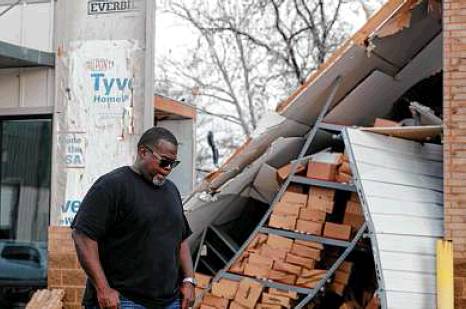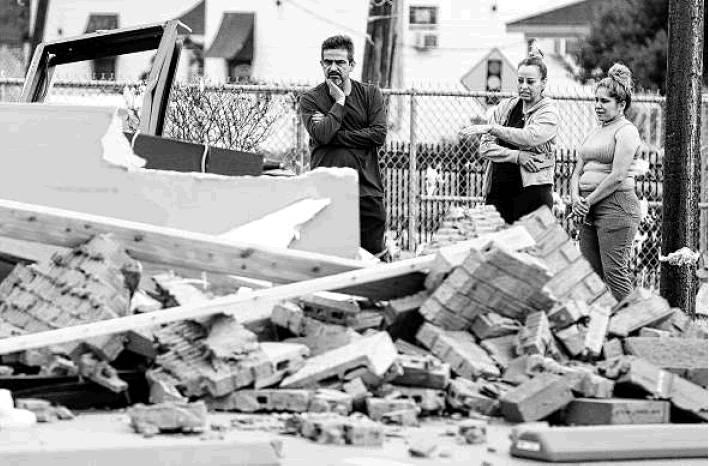It’s not Tornado Alley, but twisters still are common here
By Andrea Leinfelder STAFF WRITER
Tornadoes aren’t uncommon in Houston. They’re just not memorable.
Houston and the 100-mile area around it will see a tornado seven days a year on average, said Christopher Nowotarski, associate professor of atmospheric sciences at Texas A&M University. But often they don't cause enough damage to be memorable — or they’re overshadowed by a hellacious hurricane.
The Houston area tends to get weaker EF-0 or EF-1 tornadoes with winds maxing out at 110 mph. This most recently occurred between Saturday afternoon and early Sunday morning when a warm front and coastal low-pressure system brought six tornadoes to the Houston area.
Three of these tornadoes were classified as EF-1, one tornado was classified as EF-0 and the National Weather Service’s Houston/Galveston office had preliminarily classified the final two tornadoes as EF-0. Its personnel will continue conducting damage surveys on Tuesday to confirm the final EF-0 ratings.
Still, every now and then Houston sees a big one. In 1992, an EF-4 tornado touched down near the Houston Ship Channel. EF-4 tornadoes have winds between 166 mph and 200 mph. This storm, only the second EF-4 on record to hit the Houston area, damaged or destroyed 271 homes and injured 15 people, said John Allen, associate professor of meteorology at Central Michigan University.
He said EF-2 and EF-3 tornadoes with winds between 111 mph and 165 mph can occur once or twice a decade.
“High-end tornadoes are not unheard of in Houston, but they’re the sort of thing you might see once or twice a decade,” Allen said. “Weaker tornadoes are more common.”
That poses a question: If tornadoes occur on an annual basis, why do many Houstonians not remember them or consider them a threat?
The weaker tornadoes often don’t cause enough damage to be memorable. An EF-1 will damage roofs, snap branches and throw around debris, but it doesn’t typically destroy an entire house like what’s conjured in the movie “Twister.”
Some of these tornadoes move onshore only a short distance or move along the beach, which doesn’t cause as much damage. And Houston-area tornadoes are often associated with hurricanes.
Hurricane Harvey, for instance, produced 52 tornadoes, many of which occurred in the Houston area.
Those tornadoes weren’t as memorable as the torrential downpour and flooding. “That was the biggest risk to people,” Nowotarski said.
He also noted that seven days of tornadoes within 100 miles is a broad area. Hurricanes often cause widespread devastation, but a tornado could occur in a small area and not affect someone’s immediate neighborhood.
Still, Nowotarski said Houston is in an interesting location. It’s near the boundary of Tornado Alley, which he said roughly extends from North Texas through Nebraska, and Dixie Alley, a newer term created for the region from East Texas to Georgia.
He said storms in Tornado Alley peak in May and June. Dixie Alley tends to get tornadoes in the winter and spring. Houston’s location between these two areas means it can get tornadoes from the winter through June —plus the peak of hurricane season in August and September.
“What makes Houston relatively unique compared to other places is that there is no tornado season,” Nowotarski said. “They’re possible really almost any time of the year, and they’ll continue to be possible almost any time of the year.”
Research over the last several decades suggests that tornadoes are shifting to the east, with fewer storms in Tornado Alley and more in Dixie Alley, Nowotarski said. Climate change likely is playing a role in this shift, but more research is needed to confirm this.
However, this movement east isn’t bringing more storms to Houston. Nowotarski said there has actually been a slight decrease over the last three to four decades.
But it’s still important to have a tornado plan in place. Allen said it’s best to be below ground or on the ground floor in a room without windows.
“As many walls between you and the tornado as possible,” he said. andrea.leinfelder@chron.com twitter.com/a_leinfelder

